Nuke courses at fxphd
- NUMBER OF COURSES:
- 38
- TOTAL DURATION:
- 237 HOURS 55 MINUTES

Intermediate Nuke, Part 1
Building on the introductory NUK151 and NUK152 courses, this intermediate course takes a close look at more advanced tools inside of Nuke such as planar tracking, optical flow, and smartvVectors. To provide students with high-quality and real-world material, this course footage sources heavily on the upcoming documentary/biopic Breezy, directed by Dominic Stroehle.
Introduction to Nuke, Part 2
Nuke is the industry standard for node-based compositing. Whether you are just starting out in the industry or coming to Nuke from another Application, this multi-part course aims to give you a solid foundation for setting up your first shots.Building on the foundations set up in part of one of this series, part two gets much more production-oriented, with all new material shot specifically for this course.

Introduction to Nuke, Part 1
Nuke is the industry standard for node-based compositing. Whether you are just starting out in the industry or coming to Nuke from another application, this multi-part course aims to give you a solid foundation for setting up your first shots.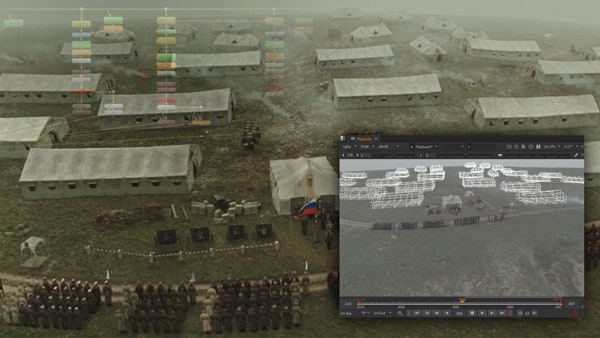
Guerrilla Nuke Compositing: War Camp Project
The course covers work done as part of post production for the 12 episode Russian TV series "Wings of the Empire". It's a companion course to AFX230 and artist Kirill Pleshakov covers the complete process of using Nuke the composite the war camp background.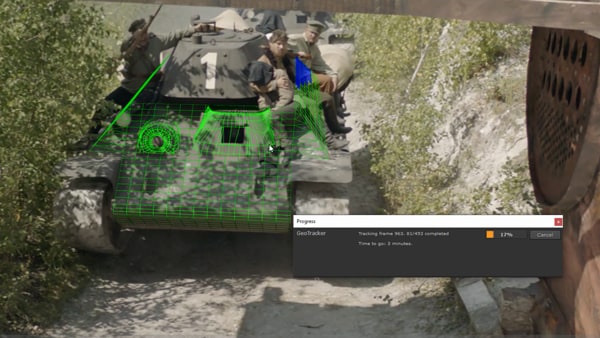
Geometry Tracking and Compositing in Nuke
This course covers two shots requiring 3D tracking of tanks, utilizing KeenTools' GeoTracker. The goal is to put CG hatches on the tanks, which had to be removed on production for safety reasons so that the drivers could see better while driving on set.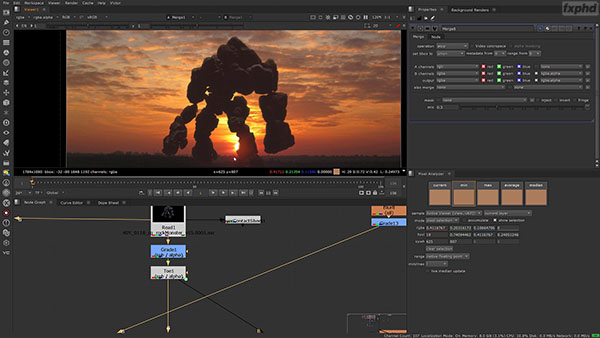
Photorealism in Compositing with NUKE: Case Studies
The second part of this two-part course, taught by Victor Perez, focuses on putting the theory discussed in the first part (NUK312) into practice. To that end, this courses uses our case studies with a practical approach, compositing the scenes from scratch to recreate the qualities of light, from internal to external setups, in different times of the day.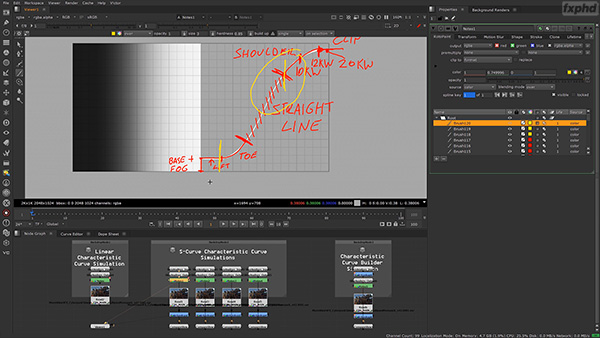
Photorealism in Compositing with NUKE: Fundamentals
The goal of the visual effects compositor is photorealism, using the art of compositing layers of images to look coherent using the physics of light at the service of storytelling. The art of compositing consists of merging two or more images making them look like they have been shot at the same time with the same camera and lenses, under the same lighting conditions.
Photogrammetry with Metashape and Nuke
Photogrammetry without a 3D software? Yes! This course is designed for compositors that want to integrate objects generated in Metashape without the help of a 3D software. In this course, you will learn how to solve 3D objects in Metashape from scratch and then see various tricks on how to import them inside Nuke so that you can push your composites to the next level.
NUKE Tips and Tricks, Volume 4
Continuing the “Tips and Tricks for Nuke” series, Hugo Léveillé builds upon the previous courses, showing useful tips and tricks that you can apply on the job.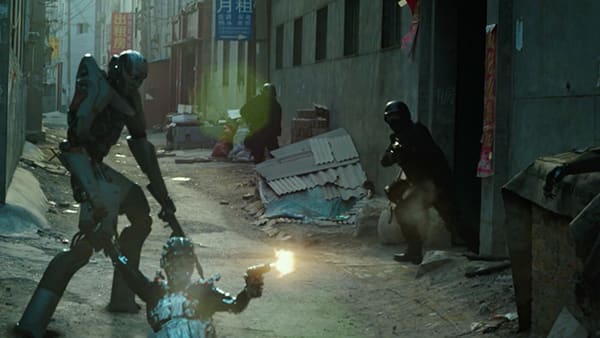
Nuke and the VFX of RISE
In this project-based course, Abhimanyu Tanwar works through the compositing aspects of several shots he completed for the short film RISE. The course starts with ingesting media inside Nuke Studio and building a compositing workflow. He then dives into creating clean plates and CGI integration into those scenes.The scenes also provide an opportunity to demonstrate how to set up matte painting and clean plate projection techniques utilizing Nuke's 3D system. For premium members, this course contains over 20GB of high resolution source files from the scenes demonstrated in the course.

NUKE Tips and Tricks, Volume 3
Continuing the “Tips and Tricks for Nuke” series, Hugo Léveillé builds upon the previous courses, showing useful production tricks that you can apply in your scripts. These tips are as short as 5 minutes to some over 45 minutes and are aimed to help you in your everyday compositing. We think this is going to be an incredibly popular series to help you take your skills to the next level.Hugo Léveillé is currently head of compositing at Mels studios in Montreal. With over 10 years of VFX experiences, he also shares his work time by creating and integrating pipeline tools for Nuke.

The Art and Science of Green Screen Keying, Part 2
Professor Victor Perez has designed this two-part course to teach you all the available keying tools in Nuke X and how to use them to pull a key as a real pro. In part two of the course, Victor builds upon the theories learned in Part 1 and dives into using the tools and showing techniques on how to get great keys in Nuke X. '
NUKE Tips and Tricks, Volume 2
In our second of our new “Tips and Tricks for Nuke” courses, Hugo Léveillé shows useful production tricks that you can apply in your scripts. These tips are as short as 5 minutes to some over an hour and are aimed to help you in your everyday compositing. We think this is going to be an incredibly popular series to help you take your skills to the next level.
NUKE Tips and Tricks, Volume 1
In our first of several new “Tips and Tricks for Nuke” courses, Hugo Léveillé shows useful production tricks that you can apply in your scripts. These tips are as short as 5 minutes to some over an hour and are aimed to help you in your everyday compositing. We think this is going to be an incredibly popular series to help you take your skills to the next level
The VFX of Race
In this training, Hugo Léveillé will be showing how MELS Studios did the VFX of the movie Race. We'll see various techniques used in Nuke as well as how they did the various crowd duplications for the stadiums shots.All of that, demonstrating with actual footage from the movie (due to rights issues, the footage used will not be available for download with the course).
NUKE Tips & Tricks for TDs
In this course, you'll learn useful python techniques for Nuke that you can use in your own code. Prof Hugo Léveillé will show you how you can use the regular expressions module, which is a module that a lot of people don’t use because of its somewhat complicated syntax. You'll also see how to build a shot time calculator inside Nuke using the threading module as well as some other techniques along the way.
The Art and Science of Green Screen Keying, Part 1
Professor Victor Perez has designed this two-part course to teach you all the available keying tools in Nuke X and how to use them to pull a key as a real pro. In part one of the course, Victor provides a detailed overview of concepts every artist should know regarding keying and then dives into covering the keyers available in Nuke X.
Immersive VR Compositing in Nuke
In this course you will learn about the exciting world of Immersive Entertainment. From LBE (Location Based Entertainment) venues to the emerging world of VR we will employ a combination of complex view dependent techniques to create imagery that is meant to be projected on a flat surface but look three dimensional and have parallax from the point of view of the observer. These techniques are used for multimedia rides at theme parks, building projections, and VR technologies.
Advanced VFX: The Desert Truck Scene
We recreate a VFX shot from a plate to a final comp, including FX, Modeling/Texturing/Lighting, Matte Painting and Compositing.We'll start from a dedicated plate of a truck in a desert, and from a Matchmove Camera, we'll recreate a brand new environment made of rocks, a distant city, and a big sand storm coming on us.

Hollywood Nuke Techniques for Indie Projects
With independent productions for new media on the rise, we’ll discuss what we can learn from bigger pipelines and how we can condense and use some of those techniques to enhance and speed up our smaller productions and budgeted pipelines.We're excited to be working with Corridor Digital, a highly successful YouTube content creator, with over 3.5 million subscribers and videos which regularly receive over 20 million views. Using Corridor Digital's footage, we'll find shortcuts in plotting out and creating effects and see how Nuke and its true 3D compositing environment can speed up out work and make it look top notch!

Nuke, Motion Control & Deep Compositing
After a successful previsualization of our skateboarding spot in our MYA223: Previz for Commercials course, we now move into production for this advanced Nuke course. For principal photography, we will be working with Stiller Studios to create incredible high speed motion control photography.Taught by Victor Perez, the first several lessons will work through production of the shoot, including behind the scenes insights into the production process; insights which will be invaluable for any visual effects artist who needs to work on-set with motion control.

NUKE Commercials Finishing for Boutiques

NUKE Compositing Best Practices
Sometimes the creative process of digital compositing can be extremely complex specially when artists have too many technical tasks to focus on at the same time. In order to preserve an efficient workflow within a shot and across a whole project a smart methodology is required.Preserving high quality standards is as much important as deliver your best shot on-time. Being efficient should be as natural as breath, you don’t need to focus on it: you just do it without even thinking about that while your focus is where you really need it the most.

PySide for NUKE
In this course, we'll see how you can push Nuke's UI to the next level with PySide and find out why it can be an important skill for artists to add to their repertoire. With PySide, you'll be able to make your panels much more dynamic and interactive.Professor Hugo Léveillé begins the course by examining the most useful widgets of PySide with their most useful functions. Then, you’ll see how to add interactions between these widgets using PySide's signals / slots and events. We'll also go over the style sheets of PySide to give our panels a personalized look.

Hit the Ground Running with NUKE Studio
In this course, prof Hugo Guerra will cover Nuke Studio, the latest addition to the Nuke family from The Foundry. Nuke Studio is the combination of the most powerful compositing toolset in the Industry, Nuke, with one of the most robust conforms tool in the market today, Hiero. Nuke Studio has been designed to give you a full suite of tools for composting, shot management, conform, review and finishing for visual effects productions, enabling very collaborative workflows.
The Dark Art of Digital Beauty Work
This advanced course looks at the techniques used to improve the physical appearance of on-screen talent; techniques which are useful on almost every single project. Prof Nathaniel Westveer will be sharing production-proven approaches for creating seamless digital beauty, which is a mash up of various practices sometimes referred to as digital beauty work, digital cosmetics, and digital beauty retouching.
Digital Matte Painting Techniques III
Ludovic Iochem returns for a new course to keep sharing digital matte painting and environment tips and techniques on a bigger project, from the matchmove, to the compositing of the CG Environment. In this new course, we'll push the technique to the 2.5D Environment and will learn how to create a CG Environment, from a Matchmove Camera, to the 2.5D Script in Nuke, through the layout in Maya and DMP in Photoshop. This is the third part in our series on digital matte painting by Iochem.
Python for NUKE and Gizmology
Python is a programming language whose design philosophy emphasizes code readability allowing you to work faster and to integrate Nuke operations more effectively. A must-know subject for hight level Nuke artists, such as compositors, digital matte painters, technical directors, roto and prep artists. You can learn to use Python and see almost immediate improvements in productivity.Professor Victor Perez has designed this course to provide you with the knowledge to read, manipulate or write your Python scripts, execute your own operations in the Nuke environment, manipulate and customize the Nuke GUI, and the most important, give you the keys to allow you to improve your Python skills by your own research and development.

Advanced NUKE & Digital Environments
This advanced course offers students the opportunity to work through 3 demanding shots – from the first steps to the finishing touches – employing on the way a variety of techniques to tackle some tough challenges.The VFX industry is in constant flux, and artists see a growing need to develop a wider scope of CG skills and be prepared to deal with a variety of VFX challenges. Taught by Emmy and VES award winning supervisor Eran Dinur, the course addresses this need by treating different tasks – compositing, modeling, lighting and matte painting – as one continuous process.

Painting and Reconstruction Techniques with NUKE X
Removals and digital matte painting fundamentals are essential skills for a compositor, but mastering these techniques requires a high level of technical understanding in order to facilitate the work, increase the speed and improve the results. Professor Victor Perez has designed this course to show you the hard craft of painting and removing elements from a shot in a simple still technically advanced way.
Advanced Matte Painting
For this advanced course, profs Ludovic Iochem and Nick Marshall will be working through one of the main reveal shots in the short film The Last Chick, where our female lead finds herself in a deserted Mexico City. In our hero shot, she walks out onto her balcony overlooking the city and as the camera moves past her we see a city void of people. Professors Ludovic Iochem and Nick Marshall will share principles and techniques they use in their jobs as Digital Matte Painter and Environment Artists at Double Negative in London.
Production Nuke Finishing
In this advanced level NUKE course, members explore what it takes to truly take a shot to final, from a film visual effects perspective. Professor Alex Fry, fresh off his stint as lead compositor at Animal Logic for The Great Gatsby, works through several scenes of a recent independent project and show advanced techniques for getting great composites in NUKE.Many artists are under the impression that getting a shot to final relies merely on technical correctness and creative polish. While those are obviously two major factors, an often-overlooked influenced can be the most critical: the client. And by client that could be a paying client or -- at a facility -- the person the artist is working for: a sequence supervisor, vfx supervisor, director, or even the studio. The reality is that finalling a shot isn't really about any particular skill, but rather responding to feedback correctly and giving people up the chain what they want.

Introduction to NUKE
Taught by Tahl Niran, this course will cover all of the basic tools and techniques you need to get up and running with the latest version of The Foundry's NUKE as well as give you a good solid foundation in how to composite live action footage, CG renders and even work with cameras and objects from your 3D application. Designed as a guide for people with little or no experience using the application, a good understanding of photoshop, after effects or similar application is recommended.
NUKE and Digital Environments
Taught by Emmy and VES award-winning artist Eran Dinur, this course stems from the belief that compositors should not only be able to seamlessly incorporate CG elements into photographic environments, but also have a real understanding of matte painting techniques as well as the ability to create 3D elements, particles and simulations.The pivot of this course will be Nuke compositing, with an emphasis on environment integration, color, depth and light. We will strive to achieve photo-realism through plate matching and studying 2D imagery as three-dimensional environments. We will explore different Nuke techniques for lighting, volumetrics, atmospherics, reflections, adding grime and dirt and breaking up the "CG look".
We will also cover advanced techniques for extractions and edge treatment, as well as using point position and normal passes for 2.5D relighting.

Project Masterclass: The Machine
This course, taught by Russell Dodgson, is a fully production based course. It is designed to tie in directly with its companion course, MYA214: Production-based Lighting and Rendering being taught by Robert Harrington. The course will be dealing with a full vfx sequence shot bespoke for the course. The lessons will attack a variety of compositing tasks and will pay attention to how we view a sequence as a whole as well as concentrating on the minutia of each individual shot.One of the course's main goals is to get full understanding of how we should approach the compositing of cg elements, and correctly using renders to rebuild our cg in comp so that we can adjust certain passes without incorrectly corrupting the contribution of others.

Nuke and the VFX Pipeline
This is a project based course that solves real world challenges and provides insight and techniques in a visual effects workflow. Nuke is far more than compositing software...it is a robust tool set that is the hub of many studios and is often the final step in the pipeline before the images are aired or projected. Most of Nuke's tools were designed with a team based workflow in mind and nuk214 will be heavily focused on that collaborative environment covering topics rarely discussed and almost never in detail outside of the studio environment.
Advanced Nuke III
This advanced Nuke course is designed as the followup to our NUK204 intermediate level course. Professor Sean Deveraux will work through several short projects during the term which are designed to focus on real world tasks and key strengths of Nuke.